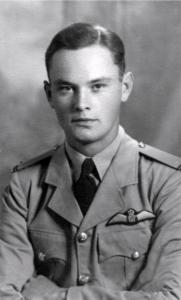
|

|
| Flight Lieutenant Geoffrey PELLING (85004) | |
|
55 Squadron Royal Air Force Date of birth: 22nd June 1921 Date of death: 13th December 1941 Killed in action aged 20 Commemorated on the Alamein Memorial Column 240 |

|
| Geoffrey Pelling was born at Toxteth Park in Lancashire on the 22nd of June 1921 the elder son of Colonel Albert James Pelling DSO MC Royal Engineers retired, a factory manager and chemist, and Margery Emily (nee Butt) Pelling, of Poilak Agadi, Kenya and of "Beach House", Portslade in Sussex. He was educated at the Prince of Wales' School, Nairobi and at Lancing College where he was in Heads House from September 1935 to 1938. On leaving school he returned to East Africa. He enlisted in the Royal Air Force Volunteer Reserve where he rose to the rank od Leading Aircraftman before being commissioned as a Pilot Officer on probation on the 24th of August 1940. He was posted to 223 Squadron in the Middle East. On the 27th of November 1940 Geoffrey Pelling was flying Wellesley Mk 1 K7660 when it suffered an engine failure at a height of 700 feet and he was forced to crash land. Although he was uninjured, his crew, Pilot Officer Frank George Buckle was slightly injured and Sergeant C. E. Moss suffered a broken bone in his left hand. The following day he, and four other Wellesleys from the Squadron, flew to Khartoum to join aircraft of 47 Squadron for a join operation the following day. At 7.10am on the 29th of November they landed at Sennar where they refuelled before taking off with five 47 Squadron aircraft at 8.10am for the attack on Danghila. The operation was a success and the aircraft all landed safely at 12.55pm. The 223 Squadron aircraft returned to Khartoum and re-joined their squadron at Wadi Gazouza on the 1st of December 1940. He was confirmed in the rank of Pilot Officer and was promoted to Flying Officer on the 24th of August 1941. He was posted to 55 Squadron. At 11.50am on the 13th of December 1941 Geoffrey Pelling and his crew took off in Blenheim MkIV V6291 from El Gubbi in Libya leading a formation of three other aircraft for a low level attack on a motor vessel in Navarin Harbour. He led the formation to a point over the sea which was 30 miles from the target and set course for the harbour. Despite poor visibility they made a perfect landfall. The merchant ship was tied up at a jetty close to two destroyers which the Blenheims had to round in order to start their bombing runs. They encountered light anti aircraft fire as they entered the harbour which became more intense as they approached their target, although much of this was inaccurate and hit the water in front of the attacking aircraft. Geoffrey Pelling’s aircraft was the first to attack followed by the other two aircraft, both of which were hit by flak as they made their run in. While the other two aircraft banked away in different directions to make good their escape, Pelling’s aircraft was seen to make its get away at low level across the rooftops of Navarin with no apprant damage. Reports from the surviving crews stated that they thought that the bombs had overshot their target. At 3.55pm an indistinct message was picked up which was thought to have come from his aircraft and when plotted, indicated that the aircraft was some 150 miles way. At 4.55pm they were attacked and shot down by a Messerschmitt Bf109 flown by the fighter ace Oberfeldwebel Karl-Heinz Bendert of Stab II/JG27, his eighth of an eventual fifty five victories. The aircraft crashed into the sea, some 10 kilometres to the north east of At Timimi, with the loss of the entire crew. Searches carried out the next day found no trace of the missing Blenheim. The crew was: - Flight Lieutenant Geoffrey Pelling (Pilot) Pilot Officer Joseph Henry Strong DFM (Observer) Sergeant Edmund Mailer Lindsay RAAF (Wireless Operator/Air Gunner) Sometime later the German authorities on Crete reported that Geoffrey Pelling's body had been washed ashore on the island of Gavdhos off Crete and that they had buried him there. In October 1946, No. 24 Graves Registration Unit made a trip to the island to recover the bodies of Allied servicemen but found no trace of his burial site. They noted that a number of known burial sites had been washed away by the sea. |
|
| Heads House |
Back